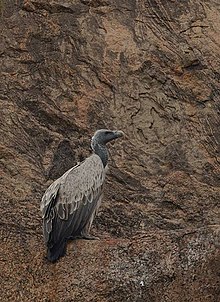Indian vulture
| Indian vulture | |
|---|---|
 |
|
| Indian vulture | |
| Scientific classification | |
| Kingdom: | Animalia |
| Phylum: | Chordata |
| Class: | Aves |
| Order: | Accipitriformes |
| Family: | Accipitridae |
| Genus: | Gyps |
| Species: | G. indicus |
| Binomial name | |
|
Gyps indicus (Scopoli, 1786) |
|
| Synonyms | |
|
Gyps indicus indicus |
|
Gyps indicus indicus
The Indian vulture (Gyps indicus) is an Old World vulture native to India, Pakistan and Nepal. It has been listed as Critically Endangered on the IUCN Red List since 2002, as the population severely declined. Indian vultures died of renal failure caused by diclofenac poisoning.
The long-billed vulture is medium in size and bulky. Its body and covert feathers are pale, its quills are darker. Its wings are broad and its tail feathers short. Its head and neck are almost bald, and its bill is rather long.
It usually is 80–103 cm (31–41 in) long and has a wing span of 1.96 to 2.38 m (6.4 to 7.8 ft). It weighs 5.5–6.3 kg (12–14 lb). It is smaller and less heavily built than the Eurasian griffon. It is distinguished from that species by its less buff body and wing coverts. It also lacks the whitish median covert bar shown by Griffon.
The species breeds mainly on cliffs, but is known to use trees to nest in Rajasthan. It may also breed on high human-made structures (like the Chaturbhuj Temple in the picture). Like other vultures it is a scavenger, feeding mostly from carcasses of dead animals which it finds by soaring over savannah and around human habitation. They often move in flocks.
The Indian vulture and the white-rumped vulture, G. bengalensis species have suffered a 99%–97% population decrease in Bangladesh, Pakistan and India. Between 2000-2007 annual decline rates of this species and the slender-billed vulture averaged over sixteen percent. The cause of this has been identified as poisoning caused by the veterinary drug diclofenac. Diclofenac is a non-steroidal anti-inflammatory drug (NSAID) and when given to working animals it can reduce joint pain and so keep them working for longer. The drug is believed to be swallowed by vultures with the flesh of dead cattle who were given diclofenac in the last days of life.
...
Wikipedia

